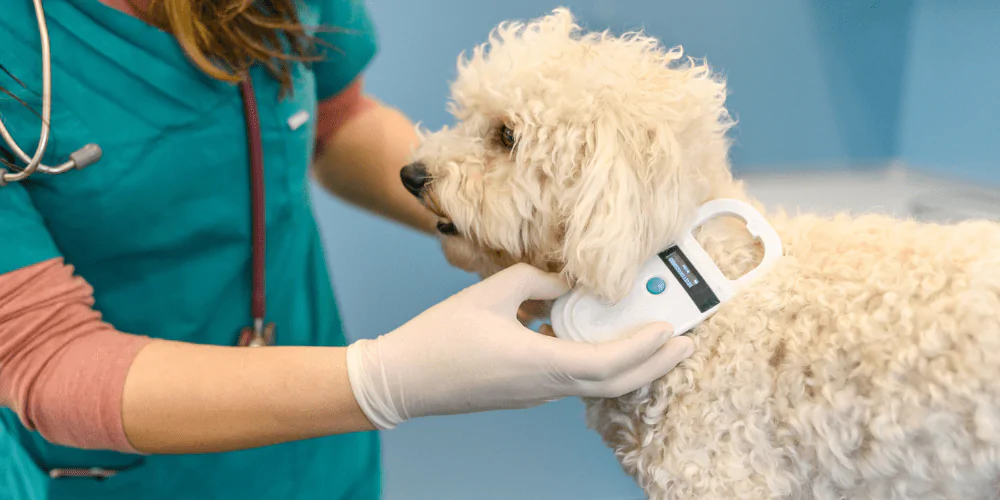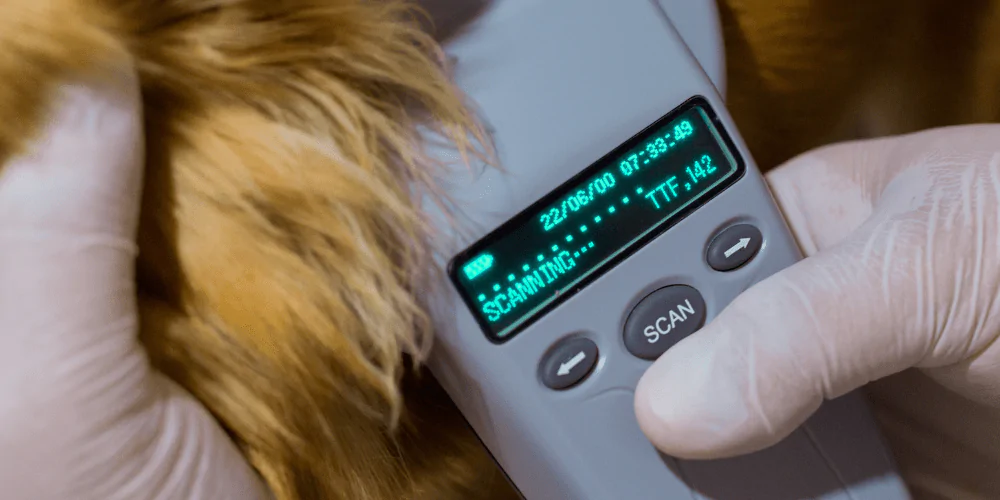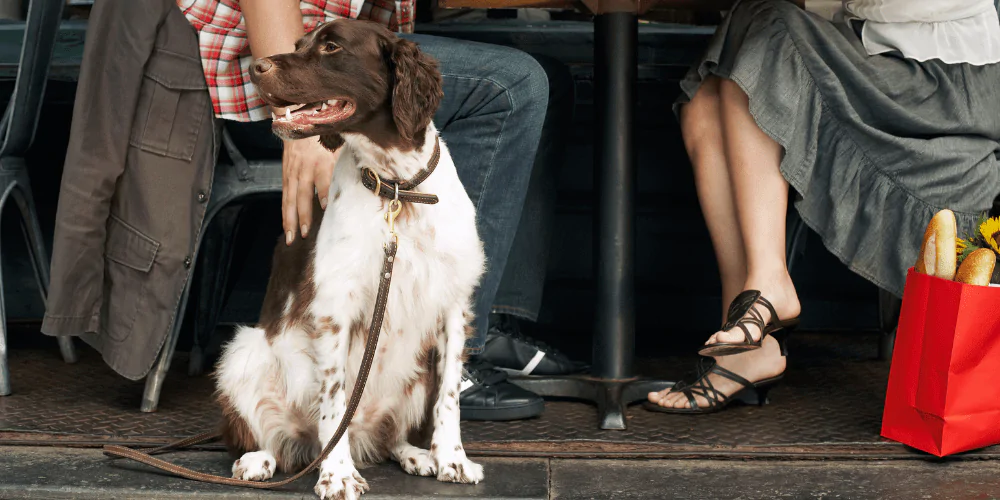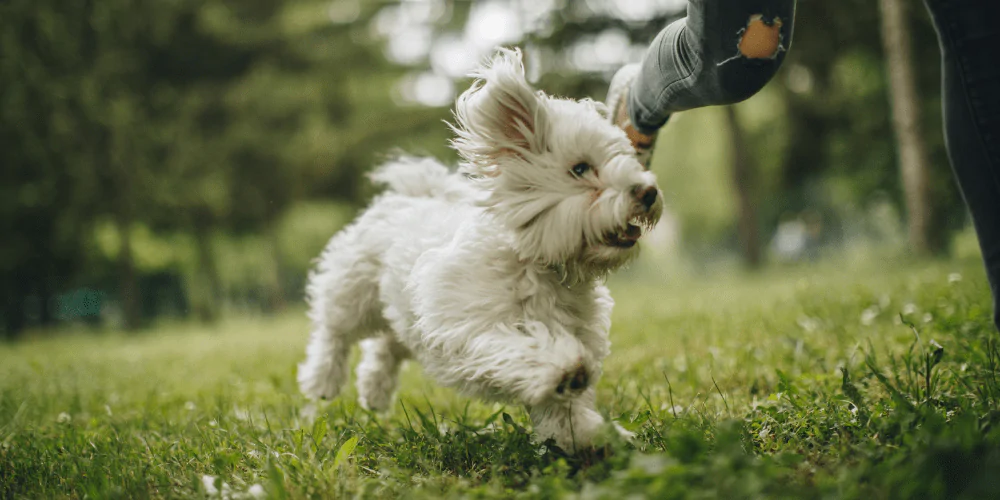
Your guide to dog theft prevention

Allie Simpson
23 March 2023 | 7 minutes read
As a responsible dog parent, it’s important to know how to help keep your pup safe from potential theft. Let’s take a look at why dogs are stolen, how you can protect them, and what to do if they go missing. You can also add missing pet cover to your dog insurance to help with the cost of getting your pet home safely.
- Why are dogs stolen?
> How many dogs are stolen each year in the UK?
> What are the most stolen dog breeds in the UK? - What dog theft laws are in place in the UK?
- How to prevent dog theft
> Get your dog microchipped
> Put on a collar or accessory with an ID tag
> Make sure your dog’s chip records are held in a compliant database
> Think about dog theft prevention devices
> Keep up-to-date pictures of your pup
> Don’t leave your dog alone in public
> Practise social media safety
> Teach your pup good recall
> Switch up your dog walks
> Be conscious of your surroundings when out with your dog
> Listen to your fellow dog community
> Secure your home and garden
> Be confident in your doggy caregivers - What to do if your dog is stolen
> How to report a stolen dog to the police
> Other places to report your dog as stolen
> Can I get dog theft insurance?

Why are dogs stolen?
Dogs may be stolen:
- To blackmail the owner for reward money
- For breeding
- To be sold on to unsuspecting new owners (especially with high demand for certain breeds or in general, such as during the pandemic)
Information found by the Pet Theft Taskforce suggests that a large amount of dog theft is carried out by Organised Crime Groups (OGCs).
> How many dogs are stolen each year in the UK?
According to the Department for Environment, Food and Rural Affairs (Defra), around 2,000 dogs were reported stolen in England and Wales in 2020.
Dogs are often reported to be stolen from homes, mainly from outbuildings and gardens.
> What are the most stolen dog breeds in the UK?
Changing trends in breed popularity and where you live in the UK can affect which dogs are seen as more desirable targets by thieves.
A November 2022 ADT report worked with police forces to collect information on pet theft over the previous five years. From the responses received, the report found that the top breeds reported stolen were:
- Staffordshire Bull Terriers (25.7% of total thefts)
- Chihuahuas (12% of total thefts)
- French Bulldogs (9.8% of total thefts)

What dog theft laws are in place in the UK?
- People who are found guilty of stealing dogs can be punished with up to seven years imprisonment under the Theft Act 1968.
- The Animal Welfare Act 2006 made it an offence to cause unnecessary suffering to animals.
- In 2021, the Animal Welfare (Sentencing) Act, saw the maximum sentence for offences under the 2006 Animal Welfare Act increase from six months to five years imprisonment.
- In January 2024, the Pet Abduction Bill was put to the Government which seeks to make abduction of cats and dogs a specific criminal offence.
The new steps being taken to protect our pets from theft under the Pet Abduction Bill would make stealing cats and dogs a criminal offence in England and Northern Ireland. As a result, those convicted of ‘pet abduction’ could face a fine, a maximum of five years in prison, or both. This marks a positive step in the right direction for keeping pets safe from harm by helping to deter thieves from committing pet theft.

How to prevent dog theft
> Get your dog microchipped
It’s the law in the UK to get your dog microchipped, and one of the reasons it was introduced was to help reunite owners with their pups if they go missing.
As a responsible pet parent, you’ve hopefully already got this one covered. Remember to keep your dog’s microchip details up to date so that you can be easily contacted if your dog is found.

> Put on a collar or accessory with an ID tag
Having an ID tag on your dog’s collar or harness is also a UK dog law.
Check that your dog’s ID tag includes your name and address to give your dog’s rescuers an easy way to reach you.

> Make sure your dog’s chip records are held in a compliant database
There’s currently 16 microchipping databases which are compliant with The Microchipping of Dogs (England) Regulations 2015.
Unless your dog’s records are held in a database which meets government standards, they’re not seen as microchipped. It can also be harder to flag and find your dog if they’re stolen.
The government website has a list of compliant microchipping databases.

> Think about dog theft prevention devices
You can pick up a range of dog theft prevention devices online and in pet stores. Remember to do your research on their effectiveness and be wary of whether they can be easily removed by thieves.
- Anti-theft lead, collar, and harnesses – reinforced with stainless steel wire to stop thieves cutting them off
- GPS tracker – you can track your dog’s live location if they go missing
- Carabiners – attach to your dog’s lead or harness and then secure onto your waist

> Keep up-to-date pictures of your pup
Keeping recent pictures of your dog can help make it easier to identify them if they go missing.
Remember to get close-up images of any unique patterns or markings they might have.

> Don’t leave your dog alone in public
Thieves are opportunists, so be wary of tying them up outside a shop/restaurant or leaving them in the car.
This is also dangerous during hotter days as dogs can easily overheat in the car.

> Practise social media safety
Be careful of who can see your social accounts and about tagging your location when uploading pictures of your pup.
Potential thieves may be able to find out the area where you live, go for walks, and spend time outdoors with your dog.

> Teach your pup good recall
Knowing your pup will come back to you when called can give you more confidence out on walks.
Follow these top tips from an expert dog behaviourist on how to teach your dog recall.

> Switch up your dog walks
Instead of sticking to the same walking routine with your dog, try mixing it up each time.
This includes:
- Where you go
- What time of day you head out
- How long you’re walking for

> Be conscious of your surroundings when out with your dog
Staying alert and aware out on walks can help you spot people acting suspiciously nearby.
Going on walks with other dog owners can also make you feel more comfortable and confident.

> Listen to your fellow dog community
Joining local online pet groups and forums can keep you up to date with news in your area. This includes any reports of suspicious behaviour from potential dog thieves.

> Secure your home and garden
Having high fencing and a lockable gate can help to deter thieves from trying to take your dog from the garden.
You can also install home security systems like video cameras and security floodlights.

> Be confident in your doggy caregivers
Always check that your pup is in safe hands if leaving them with friends, family, or professionals.
Look at reviews of dog sitters and walkers before committing and don’t be afraid to ask for proof of insurance.

What to do if your dog is stolen
How to report a stolen dog to the police
If your dog goes missing and you think they’ve been stolen, try not to panic.
- Report your dog as stolen to the police
- Give them as many details as you can, being as descriptive as possible to help them in their search
- Write down the crime reference number they give you

> Other places to report your dog as stolen
Once you’ve gone to the police, here’s who else to contact:
- Your vet
- Local rescue and welfare centres
- Your dog’s microchip database
- Your local council
- Local online missing dog boards
You could also print off missing dog posters (with pictures, details of what happened, and your crime reference number) and put these up around your local area.

> Can I get dog theft insurance?
Some providers cover missing pets as standard, while others offer this as an optional add-on.
Check your policy wording carefully to see if you’re covered and what conditions you need to follow.
Petsure dog insurance gives you the choice of adding missing pet cover to your policy. So you only ever pay for what your pup needs.


